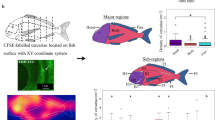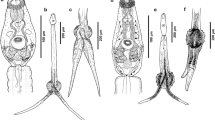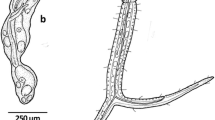Abstract
The present study provides an overview of the structures linked to fish host finding, recognition, and invasion of one of the most commonly occurring morphotypes among trematodes, furcocercariae. For this, we use free-swimming cercariae of the strigeid Cardiocephaloides longicollis (Rudolphi 1819) Dubois, 1982. Their elongated cercarial body and bifurcated tail are covered by a tegument with an irregular surface, showing numerous folds arranged in different directions and a typical syncytial organization. Both the body and the bifurcated tail are covered with short spines, rose-thorn shaped, as well as four types of sensory papillae, distinguished by the presence or absence of a cilium, its length, and their position on the cercarial body. These papillae are especially important for free-living stages that rely on external stimuli to locate and adhere to the host. A specialized anterior organ is located at the anterior part of the cercariae and is encircled by a triangle-shaped group of enlarged pre-oral spines followed by a transverse row of enlarged post-oral spines that, together with the sensory papillae, allow active finding, recognition, and penetration into fish. The ventral sucker, covered with inner-oriented spines, sensory papillae, and cilia, helps during this process. The cercariae of C. longicollis possess three types of gland cells (a head gland and two types of penetration glands), each containing different types of secretory granules that play a role in host invasion. The protonephridial excretory system consists of an excretory bladder, a system of collecting tubules, flame cells, and two excretory pores in the middle of each furcae, which serve to control osmoregulation in their marine environment, as well as to eliminate metabolic waste. Together with the four types of sensory endings, the central ganglion forms the nervous system. Our results add novel information on the ultrastructure of strigeid furcocercariae, being essential to interpret these data in relation of their functional role to better understand the transmission and penetration strategies that cercariae display to infect their fish hosts.






Similar content being viewed by others
References
Abdel-Aal AA, Soliman MFM, Shalaby IM (2004) Surface ultrastructure of Cardiocephalus longicollis (Digenea: Strigeidae) from herring gull, Larus argentatus, and its associated pathological lesions. Helminthologia 41:175–178
Abdul-Salam J, Sreelatha BS (1998) Studies on cercariae from Kuwait Bay. VIII. Description and surface topography of Cercaria kuwaitae VIII sp. n. (Digenea: Opecoelidae). Parasitol Int 47:87–94. https://doi.org/10.1016/S1383-5769(98)00002-6
Abdul-Salam J, Sreelatha BS (2004) Description and surface topography of the cercaria of Austrobilharzia sp. (Digenea: Schistosomatidae). Parasitol Int 53:11–21. https://doi.org/10.1016/j.parint.2003.10.001
Anderson RM, Whitfield PJ (1975) Survival characteristics of the free-living cercarial population of the ectoparasitic digenean Transversotrema patialensis (Soparker, 1924). Parasitology 70:295–310. https://doi.org/10.1017/S0031182000052082
Bakry FA, Atwa MT, Attia MM (2018) Three Strigeid cercariae from Littorina littorea snail, Qarun Lake, Fayoum. Egypt. Vet Worl 11:310–315. https://doi.org/10.14202/vetworld.2018.310-315
Bell AS, Gibson DI, Sommerville C (1996) Chaetotaxy and armature of Ichthyocotylurus erraticus (Rudolphi, 1809) and I. variegatus (Creplin, 1825) cercariae (Digenea, Strigeidae). Parasitol Res 83:70–76. https://doi.org/10.1007/s004360050211
Bibby MC, Rees G (1971) The ultrastructure of the epidermis and associated structures in the metacercaria, cercaria and sporocyst of Diplostomum phoxini (Faust, 1918). Z Parasitenk 37:169–186. https://doi.org/10.1007/BF00259497
Bogéa T, Caira JN (2001a) Ultrastructure and chaetotaxy of sensory receptors in the cercaria of a species of Allopodocotyle Pritchard, 1966 (Digenea: Opecoelidae). Mem I Oswaldo Cruz 96:205–214. https://doi.org/10.1590/S0074-02762001000200012
Bogéa T, Caira JN (2001b) Ultrastructure and chaetotaxy of sensory receptors in the cercariae of a species of Crepidostomum Braun, 1900 and Bunodera Railliet, 1896 (Digenea:Allocreadiidae). J Parasitol 87:273–286. https://doi.org/10.1645/0022-3395(2001)087[0273:UACOSR]2.0.CO;2
Born-Torrijos A, Poulin R, Pérez-del-Olmo A, Culurgioni J, Raga JA, Holzer AS (2016) An optimised multi-host trematode life cycle: fishery discards enhance trophic parasite transmission to scavenging birds. Int J Parasitol 46:745–753. https://doi.org/10.1016/j.ijpara.2016.06.005
Born-Torrijos A, Holzer AS, Raga JA, van Beest GS, Yoneva A (2017) Description of embryonic development and ultrastructure in miracidia of Cardiocephaloides longicollis (Digenea, Strigeidae) in relation to active host finding strategy in a marine environment. J Morphol 278:1137–1148. https://doi.org/10.1002/jmor.20700
Brachs S, Haas W (2008) Swimming behaviour of Schistosoma mansoni cercariae: responses to irradiance changes and skin attractants. Parasitol Res 102:685–690. https://doi.org/10.1007/s00436-007-0812-4
Cheng TC, Bier JW (1972) Studies on molluscan schistosomiasis: an analysis of the development of the cercaria of Schistosoma mansoni. Parasitology 64:129–141. https://doi.org/10.1017/S003118200004470X
Choi MH, Kim SH, Chung JH, Jang HJ, Eom JH, Chung BS, Sohn WM, Chai JY, Hong ST (2006) Morphological observations of Echinochasmus japonicus cercariae and the in vitro maintenance of its life cycle from cercariae to adults. J Parasitol 92:236–241. https://doi.org/10.1645/GE-354R1.1
Cohen LM, Neimark H, Eveland LK (1980) Schistosoma mansoni: response of cercariae to a thermal gradient. J Parasitol 66:362–364. https://doi.org/10.2307/3280843
Combes C, Fournier A, Moné H, Théron A (1994) Behaviours in trematode cercariae that enhance parasite transmission: patterns and processes. Parasitology 109:S3–S13. https://doi.org/10.1017/S0031182000085048
Combes C (2001) Parasitism: the ecology and evolution of intimate interactions. University of Chicago Press
Conn DB, Goater CP, Bray D (2008) Developmental and functional ultrastructure of Ornithodiplostomum ptychocheilus diplostomula (Trematoda: Strigeoidea) during invasion of the brain of the fish intermediate host, Pimephales promelas. J Parasitol 94:635–642. https://doi.org/10.1645/GE-1421.1
Cousin CE, Dorsey CH (1991) Nervous system of Schistosoma mansoni cercaria: organization and fine structure. Parasitol Res 77:132–141. https://doi.org/10.1007/BF00935427
Czubaj A, Niewiadomska K (1996) Ultrastructure of sensory endings in Diplostomum pseudospathaceum Niewiadomska, 1984 cercariae (Digenea, Diplostomidae). Int J Parasitol 26:1217–1225. https://doi.org/10.1016/S0020-7519(96)00085-9
Czubaj A, Niewiadomska K (1997) The muscular system of the cercaria of Diplostomum pseudospathaceum Niewiadomska, 1984 (Digenea): a phalloidin-rhodamine fluorescence and TEM study. Acta Parasitol 42:199–121
Denisova S, Shchenkov S (2019) New data on the nervous system of Cercaria parvicaudata Stunkard & Shaw, 1931 (Trematoda: Renicolidae): revisiting old hypotheses. J Helminthol 94:e52. https://doi.org/10.1017/S0022149X1900035X
Dorsey CH (1976) Schistosoma mansoni: description of the head gland of cercariae and schistosomules at the ultrastructural level. Exp Parasitol 39:444–459. 10.1016/0014-4894(76)90049-7
Dorsey CH, Cousin CE, Lewis FA, Stirewalt MA (2002) Ultrastructure of the Schistosoma mansoni cercaria. Micron 33:279–323. https://doi.org/10.1016/S0968-4328(01)00019-1
Dorsey CH, Stirewalt MA (1971) Schistosoma mansoni: fine structure of cercarial acetabular glands. Exp Parasitol 30:199–214. 10.1016/0014-4894(71)90084-1
Dunn TS, Hanna REB, Nizami WA (1987) Ultrastructural and histochemical observations on the epidermis, presumptive tegument and glands of the miracidium of Gygantocotyle explanatum (Trematoda: Paramphistomidae). Int J Parasitol 17:885–895. https://doi.org/10.1016/0020-7519(87)90004-x
Erasmus DA (1959) The migration of Cercaria X Baylis (Strigeida) within the fish intermediate host. Parasitology 49:73–190. https://doi.org/10.1017/S0031182000026810
Erasmus D (1970) The host-parasite interface of strigeoid trematodes. VII. Ultrastructural observations on the adhesive organ of Diplostomum phoxini Faust, 1918. Z Parasitenk 33:211–224. https://doi.org/10.1017/S0031182000040828
Erasmus D (1972) The biology of trematodes. Edward Arnold, London
Fernández MV, Hamann MI (2017) Cercariae (Digenea: Strigeidae, Diplostomidae) in Biomphalaria straminea (Planorbidae) from a rice field in Northeastern Argentina. Rev. Biol. Trop 65:551–563. https://doi.org/10.15517/rbt.v65i2.24713
Ginetsinskaya TA (1988) Trematodes; their life-cycles, biology and evolution. New Delhi, India
Goater CP, Bray D, Conn DB (2005) Cellular aspects of early development of Ornithodiplostomum ptychocheilus metacercariae in the brain of fathead minnows, Pimephales promelas. J Parasitol 91:814–821. https://doi.org/10.1645/GE-3485.1
Göbel E, Pan JP (1985) Ultrastructure of the daughter sporocyst and developing cercaria of Schistosoma japonicum in experimentally infected snails, Oncomelania hupensis hypensis. Z Parasitenkd 71:227–240. https://doi.org/10.1007/BF00926273
Gordy MA, Locke SA, Rawlings TA, Lapierre AR, Hanington PC (2017) Molecular and morphological evidence for nine species in North American Australapatemon (Sudarikov, 1959): a phylogeny expansion with description of the zygocercous Australapatemon mclaughlini n. sp. Parasitol Res 116:2181–2198. https://doi.org/10.1007/s00436-017-5523-x
Haas W (2003) Parasitic worms: strategies of host finding, recognition and invasion. Zoology 106:349–364. https://doi.org/10.1078/0944-2006-00125
Haas W, Beran B, Loy C (2008) Selection of the host's habitat by cercariae: from laboratory experiments to the field. J Parasitol 94:1233–1238. https://doi.org/10.1645/GE-1192.1
Haas W, van de Roemer A (1998) Invasion of the vertebrate skin by cercariae of Trichobilharzia ocellata: penetration processes and stimulating host signals. Parasitol Res 84:787–795. https://doi.org/10.1007/s004360050489
Halton DW (2004) Microscopy and the helminth parasite. Micron 35:361–390. https://doi.org/10.1016/j.micron.2003.12.001
Halton DW, McCrae JM (1985) Development of the tegument and alimentary tract in a digenetic trematode, Fellodistomum fellis. Parasitology 90:193–204. https://doi.org/10.1017/S0031182000049131
Höglund J (1991) Ultrastructural observations and radiometrie assay on cerearial penetration and migration of the digenean Diplostomum spathaceum in the rainbow trout Oncorhynchus mykiss. Parasitol Res 77:283–289. https://doi.org/10.1007/BF00930902
Køie M (1992) Scanning electron microscopy of cercariae, metacercariae and adults of Pygidiopsis ardeae Køie, 1990 (Digenea, Heterophyidae). Parasitol Res 78:469–474. https://doi.org/10.1007/BF00931565
Lawson JR, Wilson RA (1980) The survival of the cercariae of Schistosoma mansoni in relation to water temperature and glycogen utilization. Parasitology 81:337–348. https://doi.org/10.1017/s0031182000056079
Ligasová A, Bulantová J, Šebesta O, Kašný M, Koberna K, Mikeš L (2011) Secretory glands in cercaria of the neuropathogenic schistosome Trichobilharzia regenti-ultrastructural characterization, 3-D modelling, volume and pH estimations. Parasites Vectors 4:1–12. https://doi.org/10.1186/1756-3305-4-162
Lumsden RD (1975) Surface ultrastructure and cytochemistry of parasitic helminths. Exp Parasitol 37:367–339. https://doi.org/10.1016/0014-4894(75)90078-8
McKerrow JH, Doenhoff M (1988) Schistosome proteases. Parasitol Today 4:334–340. https://doi.org/10.1016/0169-4758(88)90002-6
McKerrow JH, Salter J (2002) Invasion of skin by Schistosoma cercariae. Trends Parasitol 18:193–195. https://doi.org/10.1016/S1471-4922(02)02309-7
Morris JP (1971) The fine structure of the tegument and associated structures of the cercaria of Schistosoma mansoni. Z Parasitenk 36:15–31. https://doi.org/10.1007/BF00328972
Niewiadomska K (1994) Adjusting of the pattern of chaetotaxy in cercariae of Diplostomum Nordmann, 1832 (Digenea) to the structure of their nervous system. Acta Parasitol 39:187–191
Niewiadomska K, Czubaj A (1996) Sensory endings in Diplostomum pseudospathaceum Niewiadomska, 1984 cercariae (Digenea, Diplostomidae). Acta Parasitol 41:20–25
Niewiadomska K, Našincová V (1990) SEM verification of armature and chaetotaxy of Diplostomum paracaudum (Iles, 1959) cercaria (Digenea, Diplostomidae). Ann Parasit Hum Comp 65:69–73. https://doi.org/10.1051/parasite/1990652069
Nittman CJ (1971) The fine structure of ciliated nerve endings in the cercaria of Schistosoma mansoni. J Parasitol 57:855–859. https://doi.org/10.2307/3277814
Paller VGV, Uga S (2008) Attachment and penetration of Centrocestus armatus (Digenea: Heterophyidae) cercariae to gills of secondary intermediate fish hosts. J Parasitol 94:578–583. https://doi.org/10.1645/GE-1402.1
Pekkarinen M (1986) Development of the cercaria of Lacunovermis macomae (Trematoda: Gymnophallidae) to the metacercaria in brackish-water Macoma balthica. Ann Zool Fenn 23:237–250 http://www.jstor.org/stable/23736133
Poddubnaya LG, Mishina E, Zhokhov AE, Gibson DI (2010) Ultrastructural features of the tegumental surface of a new metacercaria, Nematostrigea sp. (Trematoda: Strigeidae), with a search for potential taxonomically informative characters. Syst Parasitol 75:59–73. https://doi.org/10.1007/s11230-009-9207-5
Prévot G, Bartoli P (1980) Démonstration de l’existence d’un cycle marin chez les Strigeides: Cardiocephalus longicollis Szidat, 1928 (Trematoda: Strigeidae). Ann Parasit Hum Comp 55:407–425. https://doi.org/10.1051/parasite/1980554407
Podvyaznaya IM (2006) An ultrastructural study of alimentary tract development in the cercariae of Diplostomum pseudospathaceum (Digenea: Diplostomidae). Parasitol Res 99:362–367. https://doi.org/10.1007/s00436-006-0167-2
Podvyaznaya IM (2011) An ultrastructural study of alimentary tract development in the cercariae of Prosorhynchoides borealis (Digenea, Bucephalidae). Acta Zool-Stockholm 92:170–178. https://doi.org/10.1111/j.1463-6395.2010.00486.x
Poulin R, Morand S (2004) Parasite biodiversity. Smithsonian Institution Books
Reynolds ES (1963) The use of lead citrate at high pH as an electron-opaque stain in electron microscopy. J Cell Biol 17:208–212. https://doi.org/10.1083/jcb.17.1.208
Short RB, Gagné HT (1975) Fine structure of a possible photoreceptor in cercariae of Schistosoma mansoni. J Parasitol 61:69–74. https://doi.org/10.2307/3279110
Stirewalt MA, Austin BE (1973) Collection of secreted protease from the preacetabular glands of cercariae of Schistosoma mansoni. J Parasitol 59:741–743. https://doi.org/10.2307/3278879
Stirewalt MA, Dorsey CH (1974) Schistosoma mansoni: cercarial penetration of the host epidermis at the ultrastructural level. Exp Parasitol 35:1–15. 10.1016/0014-4894(74)90002-2
Stirewalt MA, Walters M (1973) Schistosoma mansoni: histochemical analysis of the postacetabular gland secretion of cercariae. Exp Parasitol 33:56–72. 10.1016/0014-4894(73)90009-x
Smyth JD, Halton DW (1983) The physiology of trematodes, 2nd edn. Cambridge University Press
Sakamoto K, Ishii Y (1978) Scanning electron microscope observations on miracidium, cercaria, and cercarial papillar patterns of Schistosoma japonicum. J Parasitol 64(1):59–68. https://doi.org/10.2307/3279610
van Beest GS, Villar-Torres M, Raga JA, Montero FE, Born-Torrijos A (2019) In vivo fluorescent cercariae reveal the entry portals of Cardiocephaloides longicollis (Rudolphi, 1819) Dubois, 1982 (Strigeidae) into the gilthead seabream Sparus aurata L. Parasit Vectors 12:92. 10.1186/s13071-019-3351-9
Whitfield PJ, Bartlett A, Khammo N, Brain APR, Brown B, Marriott MC, Clothier R (2003) Delayed tail loss during the invasion of human skin by schistosome cercariae. Parasitology 126:135–140. https://doi.org/10.1017/S0031182002002676
Wilson RA, Webster LA (1974) Protonephridia. Biol Rev 49:127–160. https://doi.org/10.1111/j.1469-185X.1974.tb01572.x
Yi-Xun H, Mi X (1994) Ultrastructural observations on cercaria of Schistosoma japonicum. Se Asian J Trop Med 25:501–508
Žďárská Z (1992) Transmission electron microscopy of sensory receptors of Echinostoma revolutum (Froelich 1802) cercaria (Digenea: Echinostomatidae). Parasitol Res 78:598–606. 10.1007/BF00936459
Acknowledgements
We acknowledge the core facility Laboratory of Electron Microscopy (LEM), Biology Centre of ASCR institution, supported by the MEYS CR (LM2018129 Czech-BioImaging). We are especially grateful to Martina Tesařová for her invaluable help in the preparation of samples. Sincere thanks to two anonymous reviewers for constructive inputs that improved the paper.
Availability of data and material
Not applicable
Code availability
Not applicable
Funding
Financial support was provided by Czech Science Foundation (no. 20-14903Y).
Author information
Authors and Affiliations
Corresponding author
Ethics declarations
Ethics approval
Not applicable
Consent to participate
Not applicable
Consent for publication
All authors approved the final version of this manuscript for its submission and publication.
Conflict of interest
The authors declare no competing interests.
Additional information
Section Editor: Shokoofeh Shamsi
Publisher’s note
Springer Nature remains neutral with regard to jurisdictional claims in published maps and institutional affiliations.
Rights and permissions
About this article
Cite this article
Yoneva, A., van Beest, G.S. & Born-Torrijos, A. Search, find, and penetrate: ultrastructural data of furcocercariae of Cardiocephaloides longicollis (Digenea, Strigeidae) explain their transmission and infection strategy into fish hosts. Parasitol Res 121, 877–889 (2022). https://doi.org/10.1007/s00436-022-07448-0
Received:
Accepted:
Published:
Issue Date:
DOI: https://doi.org/10.1007/s00436-022-07448-0




